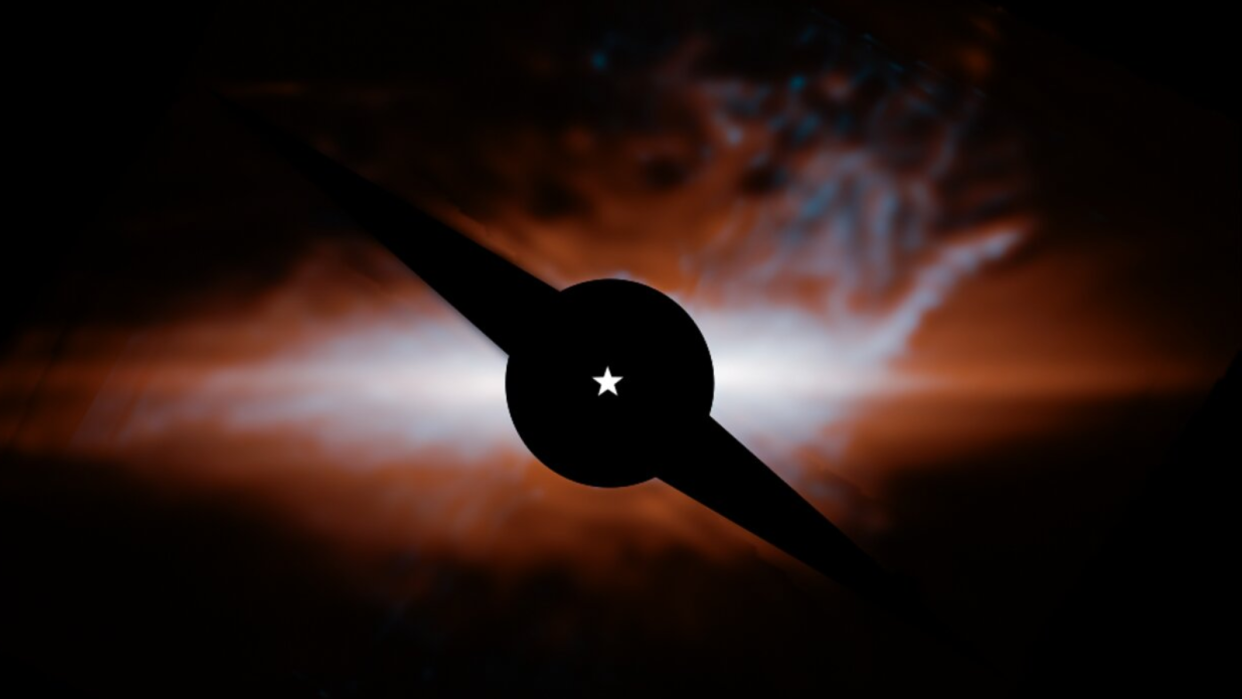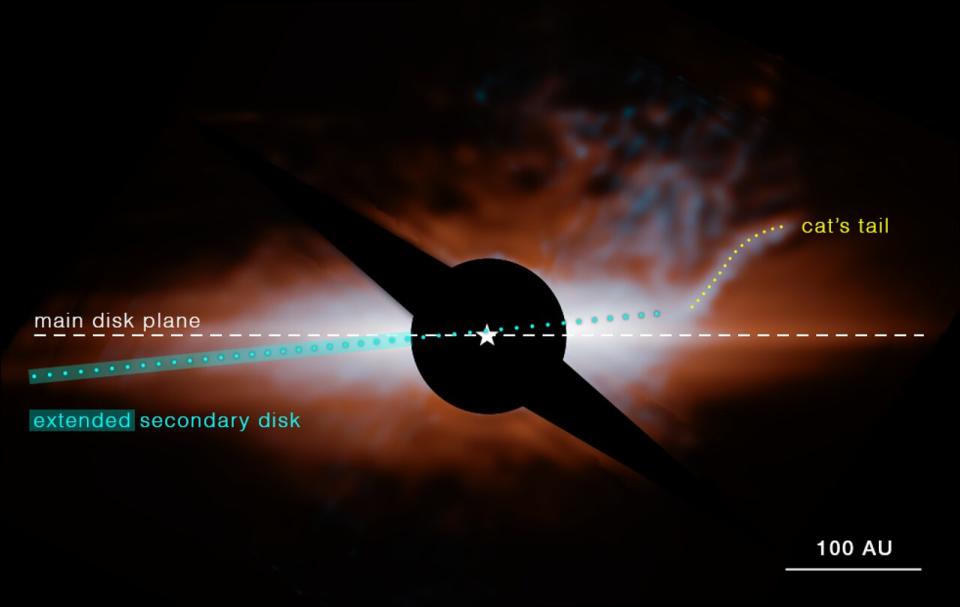James Webb Space Telescope catches young planetary system by its dusty 'cat's tail' (photo)

The James Webb Space Telescope (JWST) has seen Beta Pictoris as never before, capturing a previously unseen structure that gives the young planetary system a dusty cat's tail.
Located 63 light-years away, from us Beta Pictoris is a star around twice the size of the sun and eight times as bright, surrounded by a disk of gas and dust in which there is evidence planets have formed.
Beta Pictoris was the first planetary system around which astronomers spotted a dusty disk of material composed of debris caused by the collision of asteroids and planetesimals during the system's violent formative years. Following this, using the Hubble Space Telescope, astronomers spotted a second disk of debris and material in the Beta Pictoris system.
Now using JWST instruments — the Near-Infrared Camera (NIRCam) and Mid-Infrared Instrument (MIRI) — a team of astronomers has discovered another layer of structure in the system, in the form of a sharply inclined branch of dust extending from the southwest portion of the secondary debris disk.
Related: Astronomers solve mystery of 'Green Monster' in famous supernova remnant (photo)
"Beta Pictoris is the debris disk that has it all: It has a really bright, close star that we can study very well," study team leader Isabel Rebollido, a scientist at the Astrobiology Center in Spain, said in a statement.
"While there have been previous observations from the ground in this wavelength range, they did not have the sensitivity and the spatial resolution that we now have with the JWST, so they didn’t detect this feature," Rebollido added.
The cat's tail of Beta Pictoris only appeared to the MIRI instrument because it is shining most brightly in mid-infrared light, perhaps also explaining why it had been missed before.
Rebollido and her team also noticed another feature of Beta Pictoris. They saw a temperature difference between the two disks of the planetary system, which indicates they may have different compositions.
"We didn’t expect the JWST to reveal that there are two different types of material around Beta Pictoris, but MIRI clearly showed us that the material of the secondary disc and cat's tail is hotter than the main disc," research co-author Christopher Stark, of NASA Goddard Space Flight Center in Maryland, said in the same statement. "The dust that forms that disc and tail must be very dark, so we don't easily see it at visible or near-infrared wavelengths — but in the mid-infrared, it's glowing."
The team theorizes that the disk with the hotter temperature is comprised of dark, highly porous material that is similar to that seen at the surface of comets and asteroids in our solar system, which is known as "organic refractory material."
What put the kink in the cosmic cat's tail?
While animal behavioralists think cats put a crook in their vertically extended tails as a greeting or to indicate friendliness or playfulness, Rebollido and colleagues aren't sure what gives this cosmic cat's tail its shape. This curved feature isn't something that is seen in the disks of material in other planet-birthing systems.
To unravel this cat's cradle of a puzzle, the team modeled several scenarios to try to recreate the cat's tail structure and thus explain its origins.
"The cat’s tail feature is highly unusual, and reproducing the curvature with a dynamical model was difficult," explained Stark. "Our model requires dust that can be pushed out of the system extremely rapidly, which again suggests it's made of organic refractory material."
This investigation led the team to determine that the cat's tail had likely been caused by a dust-producing event that occurred only around 100 years ago from our perspective here on Earth.
"Something happens — like a collision — and a lot of dust is produced," research co-author Marshall Perrin, of the Space Telescope Science Institute in Baltimore, said in the statement. "At first, the dust goes in the same orbital direction as its source, but then it also starts to spread out."
Perrin added that the light from the star pushes the smallest, fluffiest dust particles away from the star faster, while the bigger grains are tougher to shift and thus do not move as much, which creates a long tendril of dust.
Related: Stunning time-lapse video captures 17-year journey of exoplanet Beta Pictoris b around its star

As for the sharp angle at which the dust tail juts away from the debris disk, Rebollido and colleagues think that this is a mere optical illusion caused by the angle at which JWST observed Beta Pictoris. The actual angle at which the dust trail extends from the debris disk is just 5 degrees.
Accounting for the brightness of this newly discovered feature, the astronomers were also able to determine that the dust in the tail is equivalent to the mass of an average asteroid in the main belt between Jupiter and Mars being spread out to a length of around 9.9 billion miles (16 billion kilometers).
RELATED STORIES:
— Scientists discover 2nd alien planet around star Beta Pictoris — and it's huge
— James Webb Space Telescope (JWST) — A complete guide
— A Jupiter-size exoplanet formed around a tiny star. Astronomers aren't sure how
The dust creation event that gave Beta Pictoris its feline feature may also be responsible for another curious characteristic of the system. The researchers think the same collision may be the cause of an asymmetry in Beta Pictoris previously observed in 2014 by the Atacama Large Millimeter/submillimeter Array (ALMA).
This asymmetry takes the form of a clump of carbon monoxide, which sits by the cat’s tail. Because radiation from the central star should take no longer than a century to break down this carbon monoxide clump, the fact that the concentration of gas still lingers could be evidence of the same event.
"Our research suggests that Beta Pic may be even more active and chaotic than we had previously thought," Stark concluded. "The JWST continues to surprise us, even when looking at the most well-studied objects. We have a completely new window into these planetary systems."
The team's research was presented this week during the 243rd meeting of the American Astronomical Society in New Orleans.

